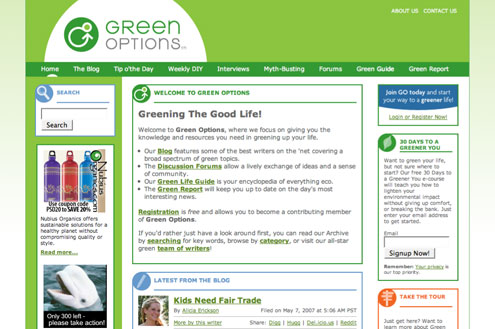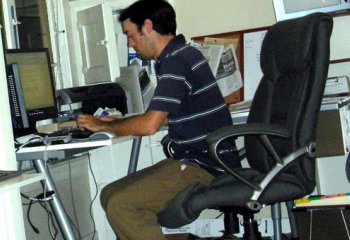This month Harvest chats with David Anderson of Green Options, a company with
a mission to help all of us find “practical, knowledge that allows [us] to live a more eco-friendly lifestyle without breaking [our] budget or seriously sacrificing comfort and convenience.”
David shares with us his insights in starting Green Options, his essential tools in
running the business, and about running a “virtual workspace”, where his employees and
contractors work from all over the country.

How did you start Green Options?
I studied international relations, sociology, and evolutionary biology at UCSDâ€â€I always thought I’d be an academic, not a CEOâ€â€but I was having trouble connecting the various aspects of human society that I studied: politics and motivations, interactions with our built and natural surroundings, as well as with each other.
Clarity came in the form of a senior year internship at a small Washington DC environmental non-profit. It was a chance to connect my political background, my interest in social change, and my latent amateur interest in renewable resources. My undergrad honors thesis ended up being a statistical analysis of the diverse drivers for renewable energy policies.
The frustrating inability to affect policy in the deadlock of DC politics gave me the desire to look to market solutions to build renewable energy markets in absolute terms, as well as through increasing public awareness and acceptance of renewable energy as anything but an alternative.
Too impatient to invest precious years into a political or policy career, I decided to set my mind to becoming an eco-entrepreneur. I started a blog about the nexus between environment and energy, met another big-thinking green blogger and entrepreneur, Shea Gunther, and GreenOptions.com was born.
What are some of the challenges so far in starting GO?
Two of the main challenges has been maintaining clear lines of communication and responsibility in an online workplace that is growing quickly but where responsibilities are often divided fluidly. The three of us that started GO (the other being Jeff McIntire-Strasburg of Sustainablog) has no communication or workflow issues when it was just us, as the team grows, the complexity of communicating effectively rises exponentially. In addition, the process of creating a company culture under these circumstances isn’t exactly nailed down yet.

If you have all the resources in the world, what would you do with GO, or what would you do instead?
My ideal project would be to administer the strategic vision for a massive federal program to take advantage of regional variation in renewable resources to get the most out of the sustainable bounty our nation has to offer. Spending even half of what we’ve spent on Iraq on a program that made smart use of our resources (natural, technological, and human) would be enough to return America to world leadership on the great global challenge of sustaining human civilization. We could create for the disenfranchised in America the green collar jobs that can be their path out of poverty, provide sustainable returns or an avalanche of investors, and secure our national future.
With that kind of investment, we could have perfected energy storage technologies that would allow the winds of the Great Plains to power much of the national grid. We could have been on our way to power most of the Southwest with large-scale solar concentrating technologies. We could be hearing announcements of the launch of wind-seeking power barges that farm the oceans for the energy to run our civilization. We could eliminate urban dependency on fossil fuels by phasing in plug-in hybrid and all electric vehicles (fueled by the solar panels on your roof?), and reduce rural dependency by promoting biofuels from waste streams. All of these things are possible, if we want them bad enough. But they aren’t yet national priorities because the current system doesn’t seem broken enough yet.
How do you market GO?
At GreenOptions.com, we say we are “greening the good life.” We focus on creating great content from green experts and enthusiasts that we hope appeals to a broad range of readers who consider themselves normal consumers. So in general, our content is our marketing. We’re writing about what people are searching for on Google: “climate change solutions,” “lenonardo dicaprio green,” “green building materials,” and the list goes on. Once people find us for one green tip, trick, or piece of information, we hope they’ll come back to learn and share more. So far, they are.
From what I’ve seen on GO’s website – it seems like a resource guide, so are you guys taking the publication path? And if you take advertising, how will GO maintain a unbiased view on such a serious subject?
It would be hard to peg us as a particular type of publication. We maintain a multi-author blog with a wide variety of interesting green content, a green news report modeled after Drudge’s linked-out format, and a wiki-based repository of information on the wide world of green living called the Green Life Guide. We do advertise, but any content we publish is fully transparent in terms of product promotion. Our Senior Editor, Jeff, is a respected English professor, and we have strict editorial policies. We leave the few negative (but vocal) comments we get online because we feel their lack of good arguments makes the case for going green stronger. We believe people like to have a wide range of information, and use a broad range of perspectives to judge for themselves.
What are some tools you have at your office?
Dual-monitor custom built PC, Dell 700m Laptop, Blackberry 8700g, floor model (half price) Officemax Executive chair, At-A-Glance 2007 planner (I scribble), HP laser and Konica-Minolta color laser printers, a stack of business cards, and subscriptions to Wired, National Geographic, The Nation, Plenty, and Entrepreneur. I like to make connections between disparate spheres in marketing green concepts to the other 80% of society.
Why does GO need to track time, and how has Harvest helped in anyway?
As our virtual workplace and our team grows, the need to evolve full-time non-management employees out of the original small core team with various independent contractors has led us to more comprehensive workflow tracking and time management tools. Formal tracking wasn’t necessary when each of us was constantly in contact with the other two, but those needs have changed as GO has grown.
Is there any tool you wish you have but does not exist or is inaccessible?
Ironically enough, the cubicle. We constantly seek to maximize our ability to communicate effectively using tools like Skype, Basecamp, Google Docs and other Google services, to name a few. But there’s something you can’t replace about being able to pop over the wall of the cubicle and clarify something, especially on projects that requires close collaboration.
What are some memorable things you’ve consumed lately?
It’s memorable that I’ve started consuming much less meat since I moved to Berkeley and started GreenOptions. It’s not that I don’t like meat (my extended family are all cattle ranchers in Wyoming and Texas). Part of the reason is a book by Michael Pollan called The Omnivore’s Dilemma. It made me be much more selective in my purchasing, limiting my meats to animals that were fed what nature intended (grass, in the case of beef). But, in reality, it really has more to do with me living in my own place in Berkeley. I shop for a week or two, buy a couple meals worth of meat, and that’s just how it works out. I like fresh food.
Thank you for your time, David!















